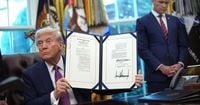The United States military’s top brass and lawmakers are abuzz following President Donald Trump’s bold move to revive a name not heard in Washington since the dawn of the Cold War. On Friday, September 5, 2025, Trump signed an executive order renaming the Department of Defense as the Department of War—a title that harks back to the nation’s earliest days and signals a dramatic shift in both tone and symbolism at the Pentagon.
The announcement, made in a ceremony at the Oval Office, was anything but subtle. Within hours, the Pentagon’s iconic five-sided headquarters in Arlington, Virginia, saw its signs swapped out. Defense Secretary Pete Hegseth’s door now reads “Secretary of War,” and his deputy, Steve Feinberg, has become the “Deputy Secretary of War.” Trump, ever the showman, declared as he signed the order, “It’s a very important change, because it’s an attitude. It’s really about winning.” According to Reuters, the move is part of a larger campaign to rebrand the military’s image and mission under his administration.
For supporters, this executive order is about more than just words. Republican lawmakers wasted no time: Senators Mike Lee of Utah and Rick Scott of Florida, alongside Representative Greg Steube of Florida, introduced legislation the same day to make the name change permanent. Defense Secretary Hegseth, who has long championed the shift, cheered, “We’re going to go on the offence, not just on defence. Maximum lethality, not tepid legality.” As reported by Fox News Digital, Hegseth described the move as a “cultural reset,” emphasizing, “Words matter. Titles matter, cultures matter.”
Senator Josh Hawley of Missouri, speaking on Fox News, threw his full support behind the change, framing it as a necessary course correction after what he called the Biden administration’s “ideological drift.” Hawley said, “I see this as about getting back to mission, Laura. Which is about recruiting war fighters to fight the wars that protect America. What Biden did for the last four years by turning the military into a giant DEI seminar has got to end.” He went on to criticize past military funding of transgender surgeries and abortions, denouncing such programs as “totally outrageous.”
Hegseth’s vision for the newly minted Department of War goes beyond symbolism. He recently ordered the creation of the Joint Interagency Task Force 401, a new unit led by Army Secretary Dan Driscoll, tasked with unifying anti-drone operations across all military branches. This comes as the Army has tested key systems under “Project Flytrap,” conducting live exercises in Poland in response to the rapidly evolving landscape of drone warfare, as reported by the Daily Caller News Foundation.
But not everyone is celebrating. Critics, including prominent Democrats, warn that the change risks glorifying war, unsettling allies, and distracting from more urgent priorities. Senator Andy Kim of New Jersey quipped on X, “Totally something my 8-year-old would come up with. Americans want to prevent wars, not tout them.” Senator Mark Kelly of Arizona added pointedly, “Only someone who avoided the draft would want to rename the Department of Defense to the Department of War.” According to Fox News Digital, former Defense official Frank Rose offered a pragmatic take: “The real question is this: Will this name change allow us to get capability faster to the warfighter and stay ahead of Russia and China? I’m skeptical. Names don’t deter. Capabilities deter.”
For historians, the move is rich with symbolism. The Department of War, founded in 1789, was one of the nation’s first executive agencies. It managed the Army and, later, coordinated with other branches as they emerged. In 1947, amid the devastation of World War II and the dawn of the nuclear era, Congress reorganized the military bureaucracy with the National Security Act, merging the War and Navy Departments into a single National Military Establishment. By 1949, the name was changed to the Department of Defense, reflecting a new era focused on deterrence rather than aggression.
Modern governments, including those of the United Kingdom, Germany, and Russia, have largely adopted titles emphasizing defense or collective security rather than war. According to Politico, the U.S. decision to move in the opposite direction stands out globally and marks a striking departure from decades of postwar consensus.
The financial implications of the rebranding are staggering. While Trump has downplayed the costs, saying, “Not a lot. We know how to change our brand without going crazy,” defense analysts estimate the price tag could exceed $1 billion. This includes updating signs, paperwork, digital platforms, and infrastructure at military installations worldwide. For comparison, an earlier effort by President Joe Biden to rename nine military bases honoring Confederate leaders was projected to cost $39 million—a fraction of the current estimate. Critics argue that such spending could divert funds from programs supporting military families, readiness, or diplomacy. As reported by Strat News Global, this could make the Department of War rebranding one of the most expensive symbolic changes in Pentagon history.
The executive order authorizes the use of “Secretary of War” and “Department of War” in all public communications, but legally, the department remains the Department of Defense until Congress acts. This means the change is largely symbolic for now, though the administration is pushing for legislative backing. Some lawmakers are calling for hearings to ensure proper checks and balances, raising concerns about the balance between civilian oversight and martial symbolism.
Beyond the headlines, the debate has exposed deeper questions about America’s military identity. Supporters claim the renaming restores honesty about the military’s role, acknowledging that the U.S. has long engaged in conflicts that go beyond mere defense. Jennifer Kavanaugh, a senior fellow at Defense Priorities, told Fox News Digital, “Department of War is sort of a much more accurate description of what the military does. The homeland itself is actually very secure… so I do think it calls attention to what is the fundamental role of the military here, which is fighting wars abroad, which hasn’t always advanced U.S. interests.”
Meanwhile, the Pentagon is set to release its overdue National Defense Strategy, which Politico reports will focus on homeland defense and the Western Hemisphere—a pivot that may be overshadowed by the renaming controversy. John Byrnes of Concerned Veterans for America lamented, “This story is overshadowing more important news.”
For now, the Department of War is back, at least in name. Whether this historic rebranding will have a lasting impact on U.S. military policy, culture, or global standing remains to be seen. But one thing is certain: the debate over America’s martial identity—and the price of symbolism—is far from over.



